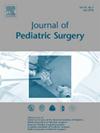长期减轻综合征性胆道闭锁患者肝纤维化替代物的作用。
IF 2.5
2区 医学
Q1 PEDIATRICS
引用次数: 0
摘要
胆道闭锁(BA)已知与其他先天性异常有关,特别是胆道闭锁脾畸形综合征(BASM)。尽管对Kasai门肠造口术(KPE)的初始反应相似,但从长期来看,他们的肝纤维化似乎更少。我们的目的是验证这一假设。方法采用单中心前瞻性数据库,同期对照比例为2:1。我们使用本地肝脏幸存者(3年以上)作为主要比较。使用了三种肝纤维化替代标志物:ast -to-血小板指数(APRi)、静脉曲张预测规则(VPR)和内镜下是否存在临床显著的静脉曲张(2级或3级)较高的APRI和较低的VPR可预测肝纤维化]。数据引用为中位数(适用的IQR),并自始至终使用非参数比较。P≤0.05为差异显著。结果在1990 - 2024年期间,共有154例综合征型BA (BASM, n= 95, Non-BASM, n= 59)和孤立性BA (n=252)患儿,其中55例(35.7%)和104例(41.3%)为3年以上的原生肝脏幸存者。三组患者KPE年龄差异无统计学意义,BASM组APRi均低于Non-BASM组和IBA组(0.63 vs 0.76 vs 0.72, P<0.01), BASM组VPR均高于IBA组(23 vs 18, P =0.02)。在3年以上的原生肝幸存者组中,与IBA相比,BASM组和非BASM组的APRi均较低(0.78 vs. 0.45 vs. 1.03, P<0.05), VPR较高(10.6 vs. 10.9 vs. 8.1)。有临床意义的静脉曲张在各综合征组中较少出现[2(3.6%)比22 (21.1%),P=0.002]。结论:与孤立性BA相比,两种综合征型BA组门静脉高压症和肝纤维化均有降低的初步临床和生物标志物证据。这可能表明,在这些综合征组中,kpe后的持续病理生物学与孤立的BA不同。本文章由计算机程序翻译,如有差异,请以英文原文为准。
Long-term reduction of liver fibrosis surrogates in syndromic biliary atresia
Aim
Biliary atresia (BA) has a known association with other congenital anomalies and specifically the Biliary Atresia Splenic Malformation syndrome (BASM). Although initial response to the Kasai portoenterostomy (KPE) appear similar, it seems that they have less liver fibrosis in the longer term. We aimed to test this hypothesis.
Methods
Single-centre prospective database with a 2:1 ratio of contemporaneous controls. We used native liver survivors (at 3+ yrs) as the principal comparison. Three surrogate markers of liver fibrosis were used: AST-to-Platelet-index (APRi), Varices Prediction Rule (VPR) and endoscopic presence of clinically significant varices (grade 2 or 3). [N.B. higher APRI and lower VPR are predictive of liver fibrosis]. Data were quoted as median (IQR where applicable), and non-parametric comparisons were used throughout. P≤0.05 was regarded as significant.
Results
During the period 1990 – 2024 there were 154 infants with Syndromic BA (BASM, n= 95 and Non-BASM, n= 59) and Isolated BA (n=252), and of these 55 (35.7%), and 104 (41.3%) were 3+ year native liver survivors. There was no significant difference in age at KPE between the 3 groups and both the APRi was lower in the BASM than both, Non-BASM and IBA (0.63 vs 0.76 vs. 0.72, P<0.01) and VPR was higher in the BASM than IBA (23 vs. 18, P =0.02) respectively. In the 3+ year native liver survivors’ group, APRi was lower in both BASM and Non-BASM groups compared to IBA (0.78 vs. 0.45 vs 1.03, P<0.05) and VPR higher 10.6 vs. 10.9 vs 8.1 (P < 0.05). Clinically significant varices were less prevalent in the syndromic groups [2 (3.6%) vs. 22 (21.1%), P=0.002].
Conclusion
There is prima facie clinical and biomarker evidence for reduced portal hypertension and presumably liver fibrosis in both syndromic BA groups, compared to those with Isolated BA. This might suggest that the ongoing pathobiology post-KPE in such syndromic groups is different to that of isolated BA.
求助全文
通过发布文献求助,成功后即可免费获取论文全文。
去求助
来源期刊
CiteScore
1.10
自引率
12.50%
发文量
569
审稿时长
38 days
期刊介绍:
The journal presents original contributions as well as a complete international abstracts section and other special departments to provide the most current source of information and references in pediatric surgery. The journal is based on the need to improve the surgical care of infants and children, not only through advances in physiology, pathology and surgical techniques, but also by attention to the unique emotional and physical needs of the young patient.

 求助内容:
求助内容: 应助结果提醒方式:
应助结果提醒方式:


